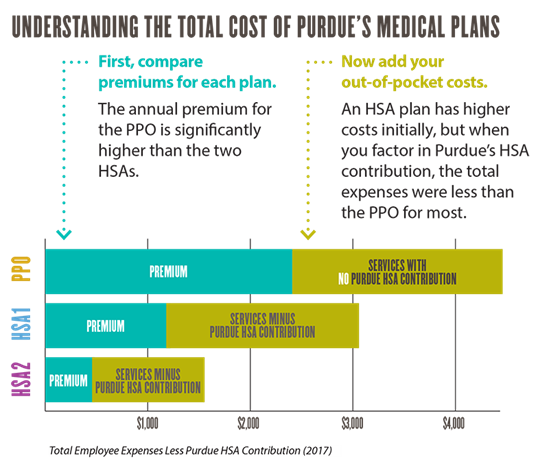Choosing the Right Medical Plan
Evaluating the best option for you and your family
PPO Plan to Go Away in 2021
Every year, it is part of our process to evaluate our benefit plans to ensure we’re balancing quality and affordability. During our analysis this past year, we concluded that the Purdue Health Plan (PPO) is no longer a sustainable or cost-effective option — for you or Purdue. This plan is costing employees and the university more money with no real overall advantage. (You can read more on that in a white paper that summarizes research on Purdue’s plans.) For that reason, the PPO plan will not be available in 2021; however, in order to help ease the transition as individuals switch plans in 2021, we are looking at a HDHP replacement that has a similar plan design and cost structure as the PPO. In the meantime, for 2020, the PPO will only be an option for those currently enrolled in it. New enrollees are not eligible.
How Medical Plan Costs Compare
The premiums for the PPO plan are significantly higher than the two HSA plans. Additionally, Purdue’s claims data shows that even though the deductible is higher with the HSA plans — which translates into higher out-of-pocket expenses during the year when services are needed — when you factor in upfront premium and Purdue’s HSA contributions ($325 – employee only / $650 – employee plus), employees are actually spending LESS with the HSA plans. The Healthy Boiler Program wellness incentive also offers employees the opportunity to double those HSA contributions and earn an additional $325 (employee only) or $650 (employee plus).

See our full medical plan cost analysis here.
Now or Later?
While current PPO members may select the PPO for 2020, you may consider transitioning now to a different plan. After all, the HSA plans offer the same provider network and free preventive care as the PPO plan. Even more, by choosing a health plan with a lower premium, you have an opportunity to put the money you save on premiums into an HSA to pay for medical services. If services aren’t needed, the tax-free money in an HSA can accumulate and over time can become an important part of your retirement savings. Between contributions Purdue will make on your behalf and adding your savings from premiums, you can gain the best value with your healthcare dollars.
FSA vs HSA
If you’ve used an FSA on the PPO plan, the HSA works in a similar fashion; however, unused HSA dollars roll over year after year and are not subject to the FSA use-it-or-lose-it provision. In other words, the HSA funds are yours to use on healthcare expenses – you never lose the funds.
One-on-One Assistance Available
Have questions about your 2020 benefit elections? You can schedule a one-on-one meeting with a Benefits representative to learn more about your options and address any questions you may have before you have to make enrollment decisions. Registration is now open and available via the Resources web page. Use your Purdue ID and BoilerKey to access registration in Successfactors. Please be sure to include a description of what you want to discuss. This helps the Benefits representative prepare for the meeting.
More Resources Available Online
We understand that selecting a medical plan for you and your family is a big decision. Our “Choosing the Right Medical Plan” video outlines some of the things you should consider when picking a plan. Plus, it takes you through a few scenarios — with single and family coverage, and if you tend to need regular medical care or just occasional care.
This year, we are adding a new tool to help you as you estimate your expenses for 2020 under each of the medical plans available to you. The tool is called Core Analytics, and you will have direct access to it when you go to enroll within Benefitfocus. Within the tool, you can estimate costs by looking at national averages of people with similar demographics. You can also personalize the data by entering what you think your healthcare needs will be in the coming year, and the tool will show you results of your estimated costs between the plans. Finally, the tool also allows you to evaluate your options by looking at your own claims’ costs over the last year. Whichever way you choose, Core Analytics will show your estimated costs, so you can compare the plans.